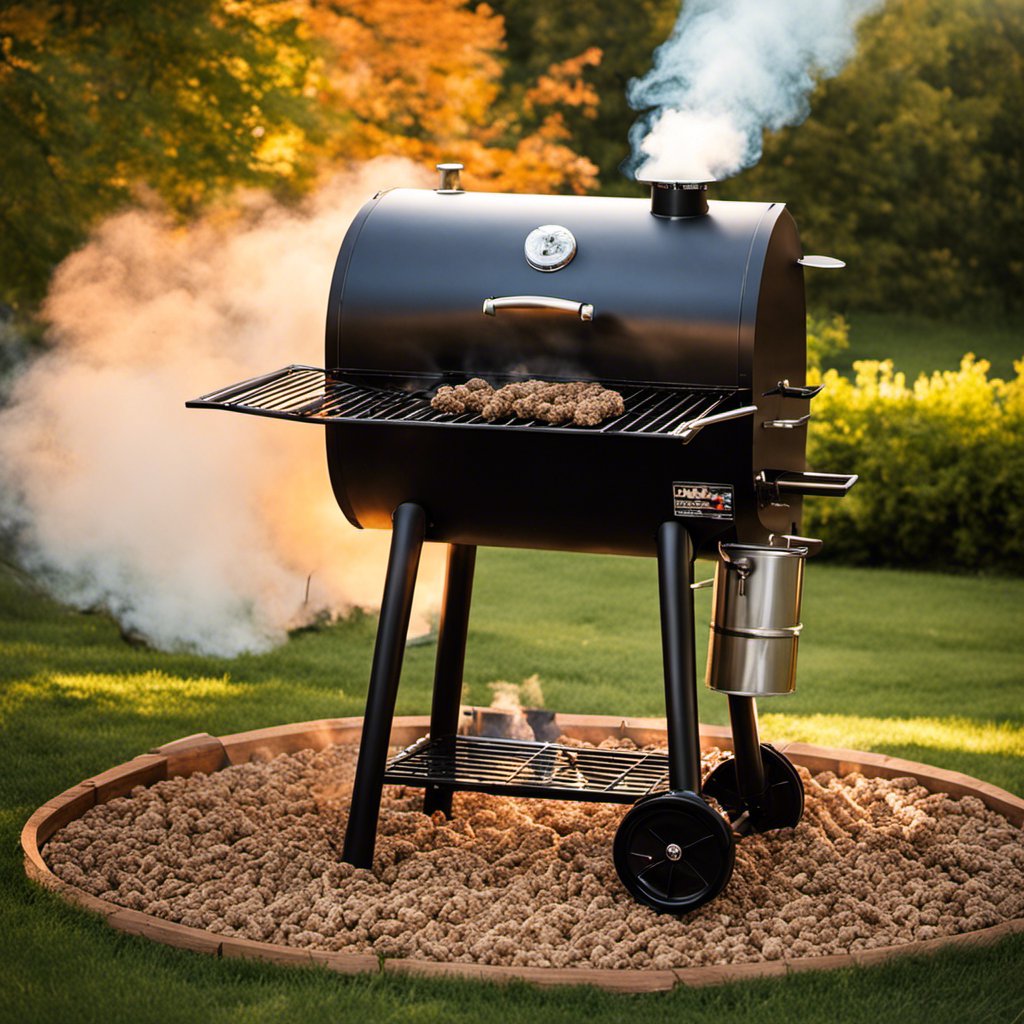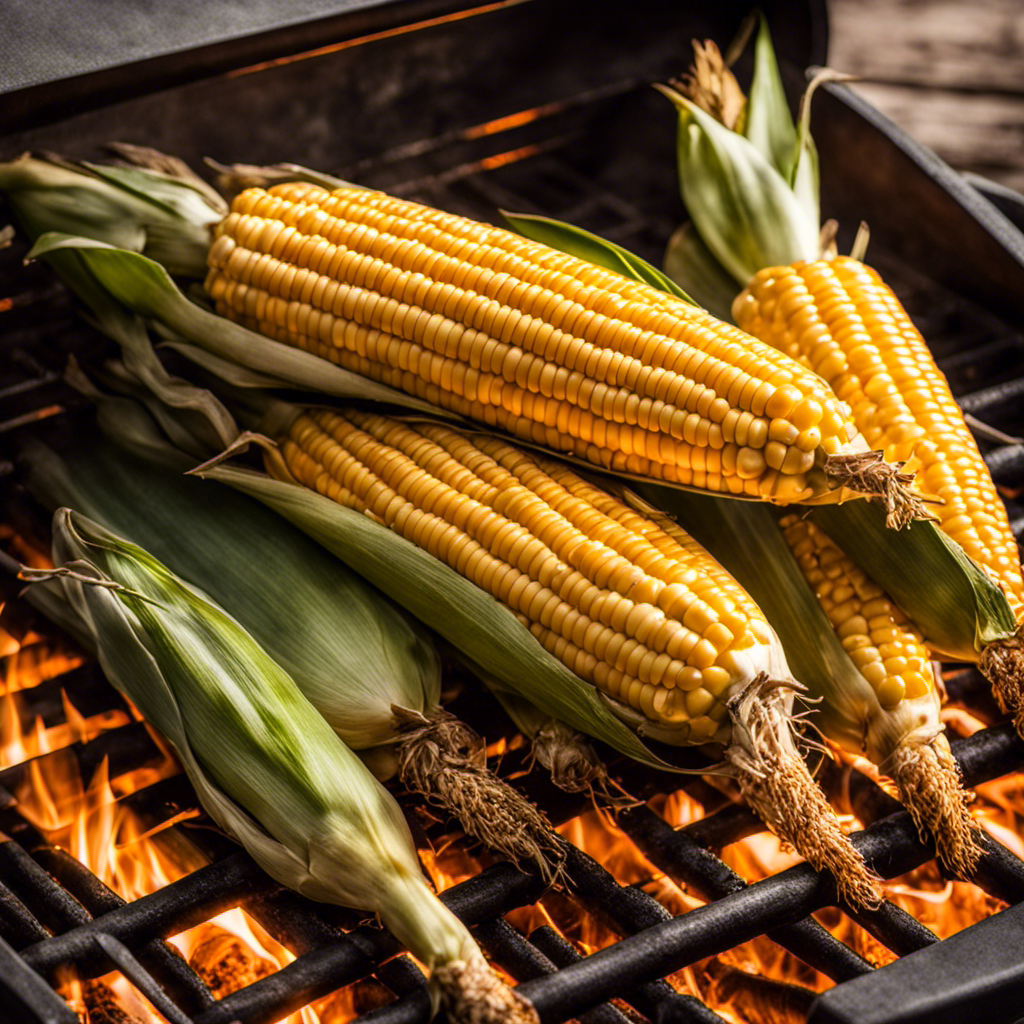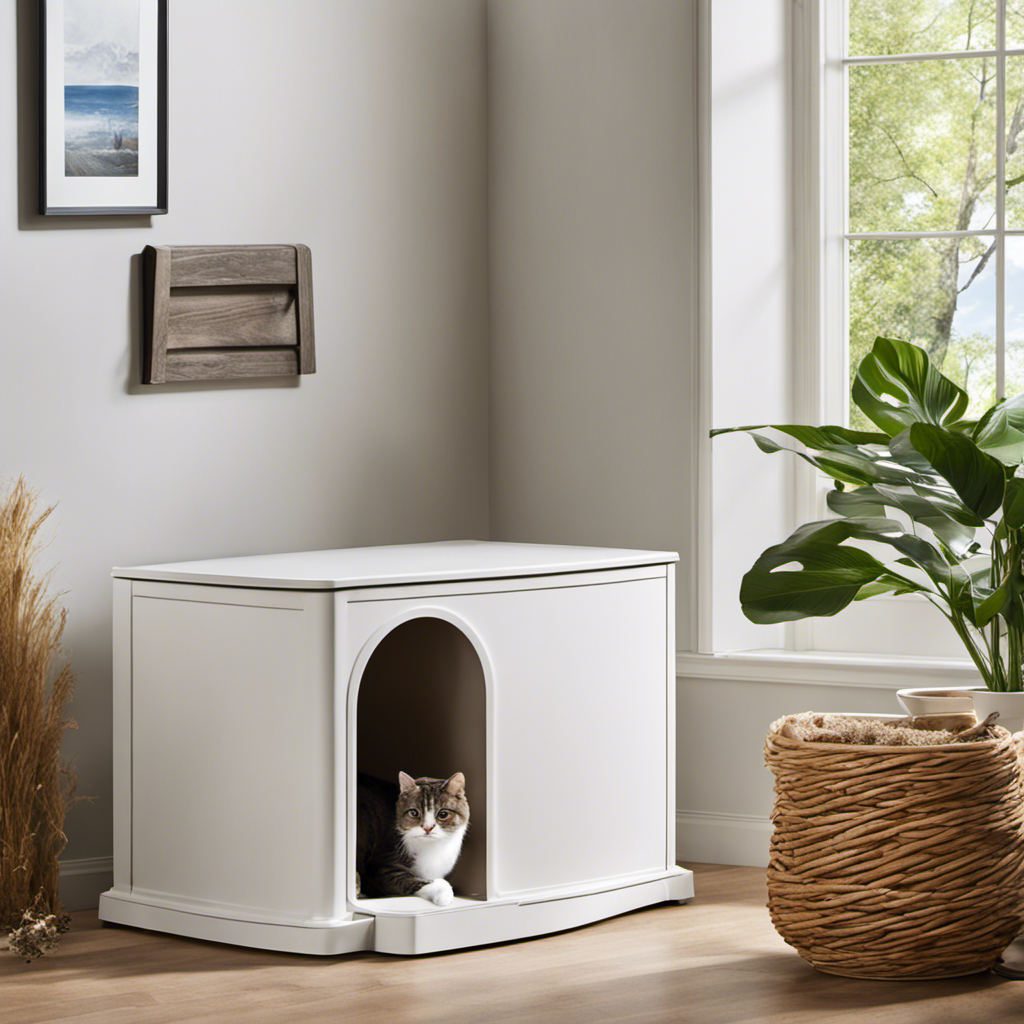I’ve always been deeply fascinated by the functioning of wood pellet smokers. Did you know that these amazing devices are capable of reaching temperatures up to 500 degrees Fahrenheit? That’s even hotter than what many traditional grills can generate!
In this article, I’ll delve into the mechanics behind these smokers and explain how they work their magic. From the fuel to the ignition system, temperature control to flavor enhancement, I’ll cover it all.
Get ready to discover the secrets behind that mouthwatering smoky flavor!
Key Takeaways
- Wood pellet smokers use small wood pellets as fuel, which are made from compressed sawdust.
- The smoker has a hopper to load the pellets and an auger to feed them into a fire pot, ensuring a steady supply of fuel for consistent heat and smoke production.
- The auger regulates the temperature within the smoker by controlling the release of pellets into the fire pot.
- The auger plays a crucial role in achieving precise temperature control, efficient fuel burning, and the perfect smoke and flavor for food.
The Basics of Wood Pellet Smokers
If you’re curious about wood pellet smokers, the basics are actually quite simple to understand. Understanding the mechanics of these smokers is key to appreciating their unique cooking abilities.
Unlike traditional charcoal or gas grills, wood pellet smokers use small wood pellets as fuel. These pellets are made from compressed sawdust and offer a clean and efficient burn. The smoker features a hopper where you load the pellets, and an auger feeds them into a fire pot. With the help of an electric igniter, the pellets start burning and produce heat and smoke. The heat is then distributed evenly throughout the cooking chamber, allowing for precise temperature control.
Exploring the different cooking methods, such as smoking, grilling, and baking, is where the true versatility of wood pellet smokers shines. Now, let’s delve into understanding the fuel: wood pellets.
Understanding the Fuel: Wood Pellets
To understand the fuel used in wood pellet smokers, you’ll need to know that the wood pellets are made from compressed sawdust. Wood pellet production is an environmentally friendly process that utilizes waste materials from the lumber industry. These pellets are created by grinding down the sawdust into small particles, which are then compressed under high pressure. This process removes any moisture from the sawdust, resulting in dense and uniform wood pellets. The table below highlights the benefits of using wood pellets as fuel in smokers:
| Advantages of Wood Pellets as Fuel |
|---|
| Efficient combustion |
| Consistent heat output |
| Low carbon emissions |
Wood pellet production has a minimal environmental impact compared to other fuel sources. Unlike traditional charcoal, which requires cutting down trees, wood pellets are made from a renewable resource. Additionally, the combustion of wood pellets produces lower carbon emissions, making them a greener option for smoking food. Now, let’s delve into the role of the auger system in a wood pellet smoker.
The Role of the Auger System in a Wood Pellet Smoker
When it comes to understanding the inner workings of a wood pellet smoker, one cannot overlook the crucial role of the auger system.
The auger’s pellet feeding mechanism ensures a steady supply of fuel, allowing for consistent heat and smoke production.
Additionally, the auger plays a significant role in regulating the temperature within the smoker, ensuring that it stays at the desired level for optimal cooking results.
Lastly, the auger’s contribution to the smoking process cannot be underestimated, as it controls the release of pellets into the fire pot, creating the perfect amount of smoke for that authentic flavor we all crave.
Auger’s Pellet Feeding Mechanism
The auger’s main function in a wood pellet smoker is to transport the pellets from the hopper to the fire pot. It plays a crucial role in the pellet feeding mechanism, ensuring a continuous and consistent supply of fuel for the smoker.
Proper maintenance of the auger is essential to ensure its smooth operation and prevent any issues that may arise. Regularly cleaning the auger and inspecting it for any signs of wear or damage is crucial. Troubleshooting auger issues can involve checking for obstructions or blockages, ensuring proper alignment, and lubricating the moving parts.
Auger’s Impact on Temperature
Make sure you regularly maintain and inspect the auger to ensure it effectively controls the temperature in your wood pellet smoker. The auger plays a crucial role in optimizing temperature control, which directly impacts the cooking time and the quality of your smoked food.
Here’s how the auger’s impact on temperature works:
-
Consistent Temperature: The auger feeds wood pellets into the fire pot at a controlled rate. This consistent fuel supply helps maintain a steady temperature throughout the cooking process.
-
Temperature Adjustments: By adjusting the speed at which the auger turns, you can increase or decrease the amount of fuel being fed into the fire pot. This allows you to fine-tune the temperature to achieve the desired cooking results.
-
Fuel Efficiency: The auger ensures that the wood pellets are burned efficiently, minimizing waste and maximizing the use of fuel. This not only saves you money but also helps maintain a consistent cooking temperature for longer periods.
With the auger’s role in temperature control understood, let’s dive into its role in smoking and enhancing flavors.
Auger’s Role in Smoking
To enhance the flavors of your smoked food, you can rely on the auger’s role in controlling the amount of fuel fed into the fire pot.
The auger, a key component of a wood pellet smoker, is responsible for delivering the pellets to the fire pot for combustion. As the auger turns, it feeds a consistent amount of pellets into the fire pot, ensuring a steady source of fuel and maintaining the desired temperature.
This controlled pellet combustion allows for precise temperature control, which is crucial in achieving the perfect smoke and flavor for your food.
However, the auger’s role in smoking is just one piece of the puzzle. The ignition system is equally important in ensuring a successful smoking experience.
The Importance of the Ignition System
When it comes to starting a fire, efficiency is key. Whether you’re camping in the great outdoors or simply trying to light up your backyard fire pit, having efficient fire-starting methods is essential.
In this discussion, we will delve into the various techniques and tools that can help you start a fire quickly and effortlessly. From reliable ignition components to safety features and precautions, we’ll cover everything you need to know to ensure a successful and safe fire-starting experience.
Efficient Fire-Starting Methods
One efficient fire-starting method for a wood pellet smoker is using an electric starter. This method not only saves time but also ensures fire safety by eliminating the need for lighter fluid or matches. Here are four reasons why an electric starter is a reliable choice for igniting your wood pellet smoker:
-
Quick and easy ignition: With just a push of a button, the electric starter generates the necessary heat to ignite the wood pellets, eliminating the hassle of manual ignition methods.
-
Consistent heat distribution: The electric starter ensures an even distribution of heat throughout the smoker, promoting efficient combustion and providing a consistent cooking temperature.
-
Environmentally friendly: By using an electric starter, you can reduce your reliance on alternative fuel sources such as lighter fluid, which often contain harmful chemicals and contribute to air pollution.
-
Long-lasting durability: Electric starters are built to withstand high temperatures and are designed for long-term use, making them a reliable and durable choice for igniting your wood pellet smoker.
With a reliable ignition component like an electric starter, you can kick-start your wood pellet smoker effortlessly and confidently, setting the stage for a successful cooking experience.
Reliable Ignition Components
Now that we understand the efficient fire-starting methods for a wood pellet smoker, let’s delve into the reliable ignition components that ensure a smooth and hassle-free cooking experience.
A wood pellet smoker relies on a dependable ignition system to ignite the pellets and maintain a consistent temperature throughout the cooking process. These systems typically consist of an electric igniter and a hot rod, which work together to ignite the pellets and create a steady flame.
In the rare event of ignition issues, troubleshooting can be done by checking the wiring connections, inspecting the igniter for damage, or ensuring that the hot rod is properly positioned. By understanding and maintaining these reliable ignition components, you can enjoy uninterrupted cooking sessions and perfectly smoked food.
Now, let’s move on to the next section, where we’ll discuss the safety features and precautions that are essential when using a wood pellet smoker.
Safety Features and Precautions
To ensure your safety while using a wood pellet smoker, it’s important to familiarize yourself with the various safety features and precautions that should be followed.
Safety precautions include keeping the smoker away from flammable materials and ensuring proper ventilation to prevent the buildup of harmful gases. It’s also crucial to regularly clean and maintain the smoker to prevent the accumulation of grease, which can be a fire hazard.
Maintenance guidelines include checking the electrical connections, inspecting the hopper for any blockages, and cleaning the ash pan regularly.
By following these safety precautions and maintenance guidelines, you can enjoy the delicious taste of smoked food without compromising your safety.
Now, let’s dive into the next section to learn about controlling temperature and heat distribution in a wood pellet smoker.
Controlling Temperature and Heat Distribution
Controlling temperature and heat distribution is key to how a wood pellet smoker works. Proper heat control ensures that your food is cooked evenly and thoroughly, while smoke production adds that delicious smoky flavor we all love. Here are three important aspects of temperature and heat control in a wood pellet smoker:
-
Digital temperature control: Most wood pellet smokers come with a digital control panel that allows you to set and maintain the desired temperature with precision. This ensures consistent heat distribution throughout the cooking process.
-
Auger system: The auger in a wood pellet smoker delivers the wood pellets to the fire pot, controlling the amount of fuel and thus the heat produced. This mechanism ensures efficient heat distribution and easy temperature regulation.
-
Airflow control: Wood pellet smokers have vents or dampers that allow you to adjust the airflow. By controlling the oxygen supply to the fire, you can manipulate the heat level and smoke production to achieve the desired cooking results.
With temperature and heat under control, let’s explore the next step in enhancing flavor with smoke and vaporization.
Enhancing Flavor With Smoke and Vaporization
If you want to enhance the flavor of your food, adding smoke and vaporization is a great way to achieve that delicious smoky taste. Smoke flavor profiles can vary depending on the type of wood pellets used.
For example, hickory pellets produce a strong, bold flavor, while fruitwood pellets like apple or cherry provide a sweeter, more subtle taste. The benefits of vaporization in a wood pellet smoker are numerous.
As the wood pellets burn, they release flavorful smoke and moisture into the cooking chamber, infusing your food with that unmistakable smoky essence. This process not only adds depth to the taste but also helps to keep your meat juicy and tender.
Now that we’ve explored how smoke and vaporization enhance flavor, let’s move on to the important topic of cleaning and maintenance of a wood pellet smoker.
Cleaning and Maintenance of a Wood Pellet Smoker
When it comes to keeping your wood pellet smoker in top shape, regular cleaning and maintenance are essential. Not only will this ensure that your smoker lasts for years to come, but it will also enhance the flavor of your food and prevent any potential health hazards.
Here are some cleaning techniques and a maintenance schedule that will help you maintain your wood pellet smoker:
- Empty and clean the ash pan after each use to prevent buildup.
- Scrub the grates with a grill brush to remove any residue.
- Clean the inside of the smoker with warm, soapy water and a sponge.
- Regularly inspect and clean the pellet hopper to prevent clogs.
- Check the seals and gaskets for any signs of wear and tear.
By following these cleaning techniques and sticking to a maintenance schedule, you can ensure that your wood pellet smoker remains in optimal condition.
Now, let’s move on to some tips and tricks for using a wood pellet smoker.
Tips and Tricks for Using a Wood Pellet Smoker
To achieve the best flavor and results, make sure you preheat your wood pellet smoker before adding your food. This step is crucial as it allows the smoker to reach the desired temperature and ensures even cooking throughout.
When using a wood pellet smoker, there are a few tips and tricks that can enhance your cooking experience.
First, experiment with different wood pellet flavors to add unique smoky flavors to your dishes. From hickory to applewood, the options are endless.
Second, try out different wood pellet smoker recipes to expand your culinary repertoire. Whether it’s smoked ribs, brisket, or even desserts, there are countless recipes available online to inspire your cooking.
Lastly, in case you run into any issues, such as temperature fluctuations or uneven cooking, consult the user manual or reach out to customer support for troubleshooting guidance.
Happy smoking!
Can I Achieve the Same Results Using a Stainless Steel Wood Pellet Tube Smoker in a Charcoal Grill as I Would with a Wood Pellet Smoker?
Yes, you can achieve similar results using a stainless steel pellet smoker in a charcoal grill as you would with a wood pellet smoker. The stainless steel pellet smoker can infuse the same smoky flavor into your meats while providing consistent and reliable heat for a delicious outcome.
Can I Achieve the Same Results with a Wood Pellet Tube Smoker as a Traditional Wood Pellet Smoker?
Yes, you can achieve the same results using a stainless steel pellet smoker tube as you would with a traditional wood pellet smoker. The stainless steel tube smoker is designed to produce the same flavor and smoke as a typical wood pellet smoker, making it a convenient alternative.
Frequently Asked Questions
Can I Use Regular Wood Chips or Charcoal in a Wood Pellet Smoker?
Yes, you can use regular wood chips or charcoal in a wood pellet smoker. However, using wood pellets provides a more consistent and controlled smoke flavor. Propane cannot be used in a wood pellet smoker.
How Long Does It Take for a Wood Pellet Smoker to Reach the Desired Temperature?
It usually takes around 10-15 minutes for a wood pellet smoker to reach the desired temperature. The key is how it maintains consistent temperature throughout the cooking process, ensuring the best smoke flavor.
Are Wood Pellet Smokers Suitable for Large Gatherings or Commercial Use?
Wood pellet smokers are suitable for large gatherings or commercial use due to their efficient fuel consumption and temperature control capabilities. They can handle the demands of cooking for a crowd without compromising on flavor or quality.
Can I Smoke Different Types of Meat Simultaneously in a Wood Pellet Smoker?
Yes, you can smoke different types of meat simultaneously in a wood pellet smoker. By using different types of wood for smoking and adjusting the airflow, you can control the smoke intensity and create delicious flavors.
What Is the Average Lifespan of a Wood Pellet Smoker?
The average lifespan of a wood pellet smoker depends on various factors such as quality, maintenance, and usage. With proper care and regular cleaning, you can extend the lifespan of your smoker and enjoy delicious smoked meats for many years.
Conclusion
In conclusion, using a wood pellet smoker is an absolute game-changer for any barbecue enthusiast. The way these smokers work, with their efficient auger systems and precise temperature control, is truly mind-blowing.
Not to mention the incredible flavor that is achieved through the combination of wood pellets and the art of smoke and vaporization. Maintaining and cleaning these smokers may require some effort, but the results are well worth it.
Trust me when I say, once you experience the magic of a wood pellet smoker, you’ll never want to go back to traditional grilling methods again. It’s a culinary journey like no other!
Logan’s affair with adventure began in childhood. He hailed from a small town where vast forests bordered one side and endless shores stretched on the other. His days were spent exploring uncharted woods, climbing tall trees, or listening to the tales of old sailors. This early immersion in a world brimming with stories and mysteries became the foundation of his passion for writing.











